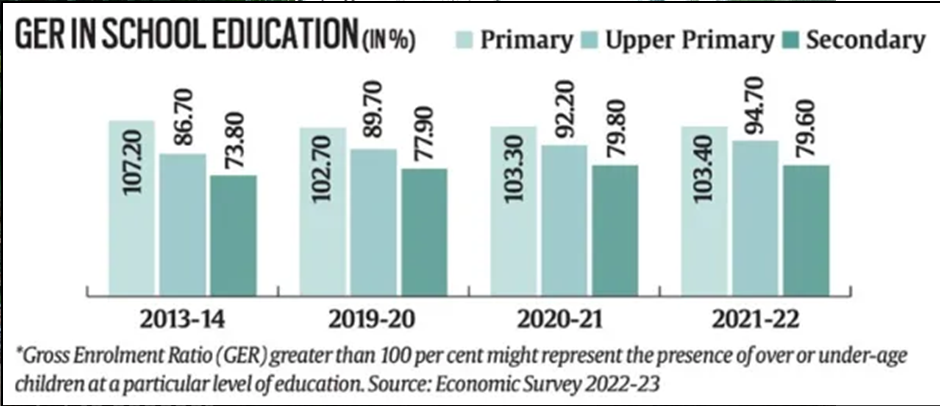A DISSERVICE TO THE EDUCATION SECTOR
Relevance:
- GS 2 – Issues relating to development and management of Social Sector/Services relating to Health, Education, Human Resources.
- GS 3 – Government Budgeting.
Why in the News?
- The Interim Budget has implemented a significant 8% reduction in allocation to higher education.
- Specifically, the University Grants Commission (UGC) has experienced a drastic cut of over 60% in its allocations.
- The reduction amounts to ₹9,600 crore less compared to the previous fiscal year’s revised estimate.
- This marks the second consecutive year of decreased funding for prestigious institutions like the Indian Institutes of Technology and the Indian Institutes of Management.
Misalignment with Education 2023: Incheon Declaration
- Objectives of the Declaration
- The ‘Education 2023: Incheon Declaration’ advocates for inclusive, equitable, and quality learning for all.
- India championed this declaration, aiming for targeted allocation of 4-6% of the nation’s GDP towards education.
- Budgetary Trend Deviation
- The Interim Budget’s allocation for education reflects a departure from the ambitious goals set by the Incheon Declaration.
- Currently, the allocation stands at approximately 2.8% of the GDP, indicating a significant shortfall from the targeted range.
Budgetary Impact on Education
- Disparities in Allocation: While school education sees a marginal increase of 0.73%, higher education faces an unyielding 16.8% reduction in allocation.
- This disparity contributes to a deepening economic burden on both educational institutions and students.
- Central Universities Funding Shift: The budget claims a 28% increase in funding for Central universities but redirects it to the Higher Education Financing Agency (HEFA) instead of the University Grants Commission (UGC).
- HEFA, a collaboration between Canara Bank and the Ministry of Education, emphasizes financial support through loans for education infrastructure development, sidelining the traditional grant-focused role of the UGC.
- Corporate Influence on Education: The shift in funding mechanisms reduces the UGC to a statutory body, emphasizing corporate values focused on cost minimization and revenue maximization.
- This compels institutions to rely on self-financing courses and loans from HEFA, transforming education into a purchasable commodity.
- Encumbrance on Marginalized Groups: The burden of financial responsibility exacerbates the educational challenges for marginalized groups, whose Gross Enrolment Ratio (GER) falls significantly below the national average.
- With a GER of 24.9%, 23.1%, and 9% for women, Scheduled Castes, and Scheduled Tribes, respectively, these groups face increased exclusion from higher education opportunities.
- Global Comparison and Fiscal Deficit: India’s GER at the higher education level lags behind the global average, standing at 27.3%, the lowest among BRICS nations.
- The fiscal deficit experienced by institutions and students contributes to the exclusion of over 72% of students from higher education opportunities.
- Call for Robust Funding:
- Despite grand declarations of a developmental ‘Amrit Kaal,’ robust funding remains crucial to bridge gaps, enhance enrollments, ensure retention, and elevate overall education quality.
- The current budgetary approach highlights the pressing need for a substantial allocation to rejuvenate and fortify the ailing educational landscape.
Allocation Challenges in School Education
- Allocation Focus:
- A significant portion of the ₹73,000 crore allocation for the Department of School Education and Literacy is earmarked for specific initiatives.
- ₹6,050 crore is dedicated to upgrading 6,448 PM-Schools for Rising India (PM-SHRI), while ₹6,399 crore is allocated for constructing new Eklavya Model Residential Schools (EMRS).
- Disproportionate Allocation:
- Despite the marginal increase in the overall budget, a substantial portion is directed towards a small percentage of schools.
- This leads to a scenario where 3% of the total budget serves only 0.7% of schools, resulting in a decrease in funding for existing schools.
- Focus on PM-SHRI Schools: These schools align with the directives of the National Education Policy (NEP) 2020.
- The higher allocation to these schools may indicate an attempt to incentivize states and union territories to fully embrace the NEP agenda.
- Impact on Other Schools: The emphasis on PM-SHRI and EMRS schools raises concerns about the neglect of existing schools.
- This leaves them struggling for resources and support, potentially compromising the quality of education provided.
- Socio-economic Inequalities:
- There’s a need for a critical examination of how NEP 2020 institutionalizes socio-economic inequalities and exacerbates existing educational challenges.
- States and union territories skeptical about the NEP agenda may face pressure to adopt it fully due to the budgetary incentives provided.
- Accountability and Disadvantaged Groups: The inquiry into NEP 2020’s impact on disadvantaged and marginalized social groups is crucial.
- Ensuring accountability and responsibility towards these groups should be a priority in educational policymaking and budget allocation decisions.
Solutions to address the Issues
- Increased funding: Raise the total education budget to meet the Incheon Declaration target of 4-6% of GDP.
- Balanced allocation: Ensure equitable distribution of funds across all levels of education, prioritizing both school and higher education.
- Improved efficiency: Utilize budgetary resources efficiently, eliminating unnecessary bureaucratic hurdles and focusing on direct impact on students.
- Focus on underrepresented groups: Allocate dedicated budget shares for affirmative action initiatives, specifically addressing gender and socio-economic disparities.
- Evaluation of NEP: Conduct a transparent and comprehensive analysis of the National Education Policy’s impact on inclusivity and educational outcomes.
- State autonomy: Provide states and union territories with greater autonomy and flexibility in implementing educational policies according to their specific needs and contexts.
- Transparency and accountability: Implement rigorous monitoring and evaluation mechanisms to ensure transparency and accountability in the use of allocated funds.
- Focus on long-term planning: Develop a sustainable long-term vision and strategic plan for education, prioritizing quality, accessibility, and equity for all.
Source: https://www.thehindu.com/opinion/op-ed/striking-the-wrong-chords-in-education/article67884942.ece
Mains question
In the context of India’s education budget, discuss the implications of disproportionate allocation towards specific school initiatives and its alignment with NEP 2020 objectives. (250 words)




